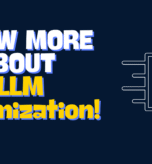AI tools like ChatGPT, Google’s SGE, and voice assistants are changing how people search online. Instead of clicking links, users now ask questions — and expect quick, smart answers. That’s where LLM Optimization (LLMO) comes in.
LLMO is about helping your brand show up in answers generated by AI. By this, businesses can appear in AI snippet. Just like SEO helps your site rank on Google, LLMO helps your content get picked up by large language models (LLMs). In this blog, we’ll explain what LLMO is, why it matters, and how you can use it to get your brand into more AI-powered conversations — simply and effectively.
What Is LLM Optimization?
LLM Optimization (LLMO) is the process of shaping your online content so that AI systems like ChatGPT, Google SGE, and voice assistants mention your brand when answering user questions. Think of it like SEO, but instead of aiming for Google’s search results, you’re aiming to be picked up by large language models (LLMs).
- Creating content that is clear and factual.
- Featuring your brand naturally in helpful answers.
- Using structured formats like FAQs and short summaries that AI loves.
- Using relevant terms and related ideas (semantic keywords) that show the AI you’re an expert in your field.
Why Does Your Brand Need LLMO?
- Stand Out in AI Conversations
When people ask AI tools for solutions or advice, you want your brand to be part of the answer. LLMO helps you do that. - Increase Brand Awareness
Even if someone didn’t know you, hearing your brand name from an AI tool builds trust and credibility. - Stay Ahead of Competitors
Fewer brands are focusing on AI mentions. By mastering LLMO early, you gain a strong advantage. - Boost Visibility in Voice Search
Voice assistants often use AI-generated responses. Being part of these answers means your brand “speaks” to users. - Drive More Organic Traffic
While LLMO isn’t the same as SEO, AI-driven brand mentions can lead users to click through to your content—especially when the AI explains why your brand matters
Key LLMO Techniques
To help your brand appear in AI-generated answers, try these tried-and-tested LLMO methods:
- Earn Mentions on Quality Sites
Get your brand name featured on trusted websites like news outlets, industry blogs, or resource hubs. AI models often pull from these recognized sources. - Use Structured Data and Schema
Add tags like Organization, Article, or FAQ schema to your site. This helps AI understand your brand, content topics, and the questions you answer. - Link from Strong Pages
Encourage blogs or sites with high search authority to link to you. These links show AI systems that your brand is relevant and credible. - Publish Authoritative Content
Create articles or guides that answer real questions in your field. AI systems are more likely to reference thorough, well-researched content.
Crafting LLM‑Friendly Content
To optimize your content for AI, make it clean, clear, and helpful:
- Write Clearly and Directly
Use simple sentences, everyday words, and a friendly tone. This style appeals to both humans and AI models. - Answer Common Questions
Include FAQ sections with short, precise answers. Phrase questions like people think or talk — e.g., “What is LLMO?” — and answer them directly. - Feature Descriptive Subheadings
Use clear headings to say what each section is about. This makes your content scannable and easy for AI to understand. - Include Semantic & Related Terms
Besides your main keywords (like “LLM optimization” or “brand visibility”), use related phrases like “AI brand mentions” or “LLM content strategy.” This helps AI grasp the entire topic. - Keep Content Updated
Check and refresh your articles often. AI systems like latest info, so regular updates help your content stay relevant.
Build Brand Authority (Entity Optimization)
If you want AI tools like ChatGPT or Google’s SGE to talk about your brand, you need to build brand authority. In simple words, AI needs to understand who you are, what you do, and why you matter. This is called entity optimization.
Start by making sure your brand is clearly explained on your website. Write a strong About page that includes your brand name, location, services, and industry. Use the same brand name and message across all platforms like social media, business listings, and online directories.
Also, get your brand mentioned on trusted websites. When well-known sources talk about your business, it signals to AI tools that your brand is credible. You don’t need to go viral, just aim for clear, helpful, and trustworthy mentions across the web.
The goal is to make your brand a “known entity” so AI models recognize and trust it when answering user questions.
Technical Checklist for LLM Visibility
For your content to show up in AI-generated answers, it’s not just about writing well; your website also needs to be technically ready. Here’s a simple checklist to improve your LLM visibility:
- Use schema markup: Add structured data (like FAQ, Organization, Article) so AI tools can easily understand your content.
- Make your content easy to read: Use short sentences, clear headings, and bullet points. This helps AI models scan and understand your content faster.
- Ensure your website is mobile-friendly: Many users search from phones, and AI tools prefer fast, responsive websites.
- Fix crawl issues: Make sure search engines and AI bots can access your content. Avoid broken links or pages blocked by robots.txt.
- Optimize your site speed: A faster site means better user experience and higher chances of your content being picked up by AI.
Measure and Improve Over Time
Once you start using LLM Optimization (LLMO) techniques, it’s important to keep track of your progress. Like with SEO, you won’t see results overnight but small changes over time can lead to big gains in visibility.
Here are a few simple ways to measure how your brand is doing:
- Test your content in AI tools like ChatGPT or Claude. Ask questions related to your brand and see if your name shows up in the answer.
- Use tools like Google Search Console and analytics platforms to track traffic to your brand pages, blog posts, or FAQs.
- Brand mentions across the web, especially on high-authority websites, directories, or forums.
- Monitor engagement on your content such as comments, shares, and backlinks which help boost your authority in AI training data.
After reviewing your results, update your content regularly. Add new questions and answers, improve clarity, and expand on topics that are performing well. AI tools are always learning and changing, so keeping your content fresh gives you a better chance of being included in future AI responses.
Conclusion
AI tools like ChatGPT and Google’s SGE are changing how people search and find information. Instead of browsing websites, users now ask questions — and trust the answers given by large language models (LLMs). That’s why LLM Optimization (LLMO) is becoming so important.
To get your brand into AI answers, you need to create helpful, clear, and well-structured content. Focus on getting mentioned on trusted websites, write in a conversational tone, and use structured data where needed. Build your brand authority by being consistent and valuable across the web.
And remember LLMO isn’t a one-time task. Keep testing how AI tools respond to your brand, track what’s working, and update your content often. The more useful and visible your content is online, the better your chances of being included in AI-generated responses.
In short, LLM Optimization helps your brand stay relevant in an AI-driven world. Start small, stay consistent, and keep showing up where your audience is asking questions.




